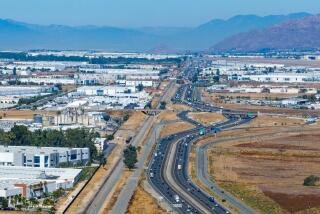Farmers Call for Central Valley Land Protection
- Share via
Uniting for the first time to combat helter-skelter development in California’s rich farm belt, a group of prominent agricultural interests today will urge governments to establish fees to discourage the loss of farmland.
In a long-anticipated report, the Agricultural Task Force for Resource Conservation and Economic Growth in the Central Valley will advocate, among other things, that builders wanting to convert agricultural land to urban uses be required to contribute to a farmland preservation fund. The idea, the group said, is to encourage farmland conservation and the development of higher-density housing to cope with an anticipated tripling of the region’s population by 2040.
Some preservation-minded observers said the report is not forceful enough and falls well short of the group’s original intentions. Builders, on the other hand, said the proposals could devastate the region economically.
In its report, the task force said about 150,000 acres of farmland were lost over the 15 years ending in 1995, as the valley population doubled to 1.8 million.
Drawing from a 1995 study by the American Farmland Trust, the group also projected that the sort of low-density urban sprawl prevalent throughout much of the valley would consume more than 1 million acres of farmland by 2040, about 60% of which would likely be prime farmland of great economic importance to the state.
*
The study forecast that such a pattern of development would reduce farm sales by $2.1 billion a year, as environmental problems and the cost of providing services would escalate. In 1996, agriculture produced $24.5 billion in sales for California farmers.
Growers and ranchers have long been divided on the topic of Central Valley development and, as the report notes, have played both sides of the issue--wanting protection from the problems associated with farming on the urban fringe while encouraging growth into rural areas by eagerly selling land to developers when the price is right.
As a result, many growers and ranchers said they view the report as a sign of progress toward building a consensus.
“Over time there has been adamant opposition from major agricultural players to the notion that it’s necessary to preserve ag land,” said Albert Medvitz, a Solano County sheep rancher. “I would like the report to be stronger, but I’m gratified that it’s there.”
In the past, he noted, farmers could always count on productivity gains to offset the loss of acreage. That is changing as water becomes more scarce.
*
Jack Pandol, the task force chairman and a lifelong farmer who lives in Kern County, said the task force spent 18 months attempting to devise a report that would “satisfy the most people.”
“I am convinced you can have development and preservation of ag land,” he said. “There need to be right-to-farm laws because we were here first. [But] we also need to be good neighbors in terms of dust and noise.”
The report notes that the lack of a coordinated planning strategy has resulted in haphazard, sprawling development as strapped cities and counties compete for tax revenues. That in turn has compounded the fiscal woes of Central Valley communities and led to increased conflicts between farmers and their urban neighbors.
*
Among the basic principles endorsed by the report:
* Local governments should use land conservation easements to provide incentives for landowners.
* Water policies should ensure an adequate and affordable supply for farming.
* The state should ensure fiscal stability for local governments so that land use decisions can be based on good planning and the long-term health of communities rather than short-term gain.
* Each county should develop a unified countywide plan with clear policies for rural and urban land uses.
Terrie Stoller, whose family owns Sunridge Nurseries near Bakersfield, applauded the report as a needed first step.
“We all feel a sense of panic [about projections of population growth],” she said. “If we keep covering up farmland to give [newcomers] houses, where are they going to work?”
Kern County, she noted, only recently reinstated a planning commission after operating without one for 18 years. The area, she said, “has been a one-stop shop for developers.”
A few years ago, her family hired an attorney to fight the city, which wanted to annex the fields on which they were growing rootstock for Napa and Central Coast wine grape growers. They succeeded in fending off the annexation, but their property is now within a quarter-mile of a subdivision. If development comes any closer, they will be forced to forgo the aerial spraying they need to combat pests.
*
Al Sokolow, a public policy specialist at UC Cooperative Extension in Davis, said the report is a substantial advance because big agriculture for the first time is putting ideas on the table.
*
Among those endorsing the report are the California Farm Bureau Federation; William Bolthouse of Bolthouse Farms, a big Kern County carrot grower and processor; John Harris of Harris Ranch; Bob Gallo of E&J; Gallo Winery; and several commodity marketing associations.
Taking strong issue with the report was the California Building Industry Assn.
“The whole report is very disturbing to us,” said Robert Rivinius, the group’s president. “It appears agriculture would like to start making land use decisions for the Central Valley.”
Cliff Moriyama, the group’s legislative advocate, said builders would especially dislike the idea of being assessed a fee for converting land to urban use. “This type of report almost begs the other side to be inflamed,” he said. “It gets the collaborative process off to a rocky start.”
More to Read
Sign up for Essential California
The most important California stories and recommendations in your inbox every morning.
You may occasionally receive promotional content from the Los Angeles Times.














